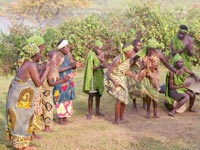![]()
 For decades, anthropologists have debated over why pygmies have evolved to be short. Amid theories about their jungle homes and lack of food, new research suggests that we have been looking at the problem from the wrong angle. The diminutive stature of pygmies is not a direct adaptation to their environment, but the side-effect of an evolutionary push to start having children earlier.
For decades, anthropologists have debated over why pygmies have evolved to be short. Amid theories about their jungle homes and lack of food, new research suggests that we have been looking at the problem from the wrong angle. The diminutive stature of pygmies is not a direct adaptation to their environment, but the side-effect of an evolutionary push to start having children earlier.
Andrea Migliano at the University of Cambridge suggests that pygmies have opted for a ‘live fast, die short’ strategy. Their short lives gives them very limited time as potential parents, and they have adapted by becoming sexually mature at a young age. That puts a brake on their pubescent growth spurts, leaving them with shorter adult heights.
Little people
Pygmies are technically defined as groups of people whose men are, on average, shorter than 155cm (or 5 feet and an inch for the Imperial-minded). Strictly speaking, the word is restricted to several ethnic groups of African hunter-gatherers, like the Aka, Efe and Mbuti. But the world is surprisingly replete with shorter-than-average groups who also bear the colloquial moniker of pygmies, including some from Brazil, Bolivia, South-East Asia and Papua New Guinea.
The earlier explanations for a short stature worked for some of these groups, but they could never account for all of them. Some scientists suggested that smaller people move more easily through dense jungles, but some pygmies live outside forests. Other theorised that they could maintain their body temperature more easily, but many live in cool and dry climes.
One of the more popular theories put forward by Jared Diamond suggested that small people are more resilient to starvation and malnourishment when food becomes scarce. But this can’t be the whole story for Africa groups like the Turkana and Massai manage to be some of the tallest people on Earth despite facing similarly unstable food supplies!
 Migliano found more evidence against this theory by comparing the growth patterns of three groups of genuine pygmies – the Filipino Aeta and Agta, and the central African Biaka – with the shortest Americans, whose malnourished childhoods landed them in the bottom 0.01% of the population in terms of adult height.
Migliano found more evidence against this theory by comparing the growth patterns of three groups of genuine pygmies – the Filipino Aeta and Agta, and the central African Biaka – with the shortest Americans, whose malnourished childhoods landed them in the bottom 0.01% of the population in terms of adult height.
Together with Lucio Vinicius and Marta Lahr, she found that the true pygmies grew slightly more slowly than the undernourished Americans, their growth spurts ended much earlier, at age 12 rather than 15. Typically, groups who lack free-flowing calories grow slowly over a long time – the pygmies’ pattern matched the first part but not the second. The pygmies’ growth curves disproved the malnutrition idea, but their lifespan pointed Migliano towards a better explanation.
Early death
Pygmies around the world are short in life expectancy as well as height, with the average adult dying at 16-24 years of age. Only 30-50% of children survive to the age of 15 and less than a third of women live to see menopause at 37. Taller African groups like the Ache or Turkana have lower adult mortality and twice the average lifespan, and compared to them, the pygmies’ pattern is closer to that of chimps.
Migliano argues that their early deaths are the driving force behind both their small size and their shorter growth spurts. It pays pygmies to divert resources away from growth and towards having children as early as possible, to compensate for their limited years. Indeed, Migliano found that they reach a peak of fertility earlier than taller groups.
 In general, people who grow taller and larger tend to be more fertile and have larger and more capable offspring. That’s obviously advantageous but not if adult mortality is so low that you may not get a chance to have children at all. In this perilous situation, natural selection favours those who mature and reproduce early, to the cost of their growth.
In general, people who grow taller and larger tend to be more fertile and have larger and more capable offspring. That’s obviously advantageous but not if adult mortality is so low that you may not get a chance to have children at all. In this perilous situation, natural selection favours those who mature and reproduce early, to the cost of their growth.
Migliano’s theory has one important missing piece that needs to be filled in – why do many pygmies die early? It is here that the other earlier explanations for their short size may come in, including tropical diseases, thick jungle environments, hot climates and poor nutrition. None of these factors alone can account for pygmy evolution around the world, but Migliano speculates that one or more of them could lower the life expectancies of different populations.
If she’s right, it means that small body size could be an example of convergent evolution, where different groups of people in disparate parts of the globe independently evolved similar solutions to the shared problem of short and hazardous lives.
Reference: Migliano, A.B., Vinicius, L., Lahr, M.M. (2007). Life history trade-offs explain the evolution of human pygmies. Proceedings of the National Academy of Sciences DOI: 10.1073/pnas.0708024105
Filed under: Being human, Evolution, Human evolution | Tagged: , body size, height, humans, life history, pygmies, science |











Very interesting, but surely differences in infant mortality, which seem to dominate their Fig. 2, don’t impose selection for early reproduction. I’d like to see a graph of chance of dying in a given year, as a function of age. If you’re likely to die in the next few years, it’s time to reproduce, even if you’re a little smaller than might be optimal otherwise. But wait, is there any point to reproducing, if you’ll be dead in five years? It depends on whether someone else will care for your orphaned kids.
It would definitely be an interesting analysis to do. But I think it’s worth noting that they make it clear that it’s differences in adult mortality rather than infant mortality that provide the selection pressures for early reproduction. I have to disagree with you about Fig 2 – it looks to me that the differences in mortality between the pygmies and the other groups seem pretty constant from infancy right up till age 45+.
once again Ed- great article- i’ve also been thinking about this- if it’s true they have genetically shorter lives-
in the interests of equitablility- should they
*pay less tax (since they’d never live to pension age)
* have a lower legal age of sexual consent (that would otherwise be considered paeophilia)?
*have less strict requirements on their minimum number of years of education – otherwise they could be middle aged by the time they finish college.
shlog
Shlog – I would normally agree with you, but given that most of these groups are still hunter-gatherers living in self-contained groups, I doubt any of those things apply to them.
ed….., shlog was joking
Since they are so different than the rest of humanity, maybe they are a seperate species altogether ?
Hi! Great Article, it explains so much, my problem is that i am writing a report on the Pygmies, and I want to in-text reference a quote, but I CAN”T CAUSE I DONT KNOW WHO YOU ARE! PLEASE HELP ME!!!!!!!!!!!!1